The Cambridge History of Japan, Vol. 1: Ancient Japan
Подождите немного. Документ загружается.

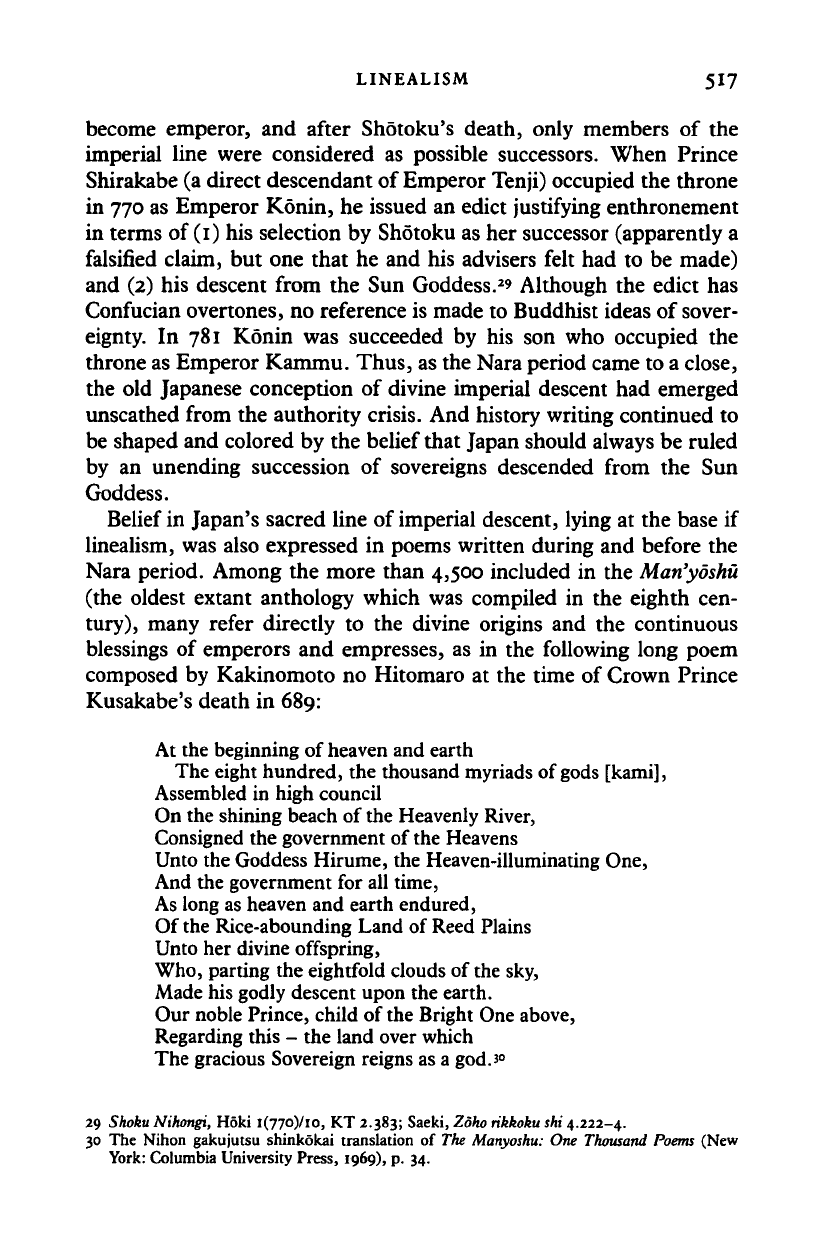
LINEALISM 517
become emperor, and after Shotoku's death, only members of the
imperial line were considered as possible successors. When Prince
Shirakabe (a direct descendant of Emperor Tenji) occupied the throne
in 770 as Emperor Konin, he issued an edict justifying enthronement
in terms of (1) his selection by Shotoku as her successor (apparently a
falsified claim, but one that he and his advisers felt had to be made)
and (2) his descent from the Sun Goddess.
2
' Although the edict has
Confucian overtones, no reference is made to Buddhist ideas of sover-
eignty. In 781 Konin was succeeded by his son who occupied the
throne as Emperor Kammu. Thus, as the Nara period came to a close,
the old Japanese conception of divine imperial descent had emerged
unscathed from the authority crisis. And history writing continued to
be shaped and colored by the belief that Japan should always be ruled
by an unending succession of sovereigns descended from the Sun
Goddess.
Belief in Japan's sacred line of imperial descent, lying at the base if
linealism, was also expressed in poems written during and before the
Nara period. Among the more than 4,500 included in the Man'yoshu
(the oldest extant anthology which was compiled in the eighth cen-
tury),
many refer directly to the divine origins and the continuous
blessings of emperors and empresses, as in the following long poem
composed by Kakinomoto no Hitomaro at the time of Crown Prince
Kusakabe's death in 689:
At the beginning of heaven and earth
The eight hundred, the thousand myriads of
gods
[kami],
Assembled in high council
On the shining beach of the Heavenly River,
Consigned the government of the Heavens
Unto the Goddess Hirume, the Heaven-illuminating One,
And the government for all time,
As long as heaven and earth endured,
Of the Rice-abounding Land of Reed Plains
Unto her divine offspring,
Who,
parting the eightfold clouds of the sky,
Made his godly descent upon the earth.
Our noble Prince, child of the Bright One above,
Regarding this - the land over which
The gracious Sovereign reigns as a god. 3°
29 Shoku Nihongi, Hoki l(77o)/io, KT 2.383; Saeki, Zoho rikkoku shi 4.222-4.
30 The Nihon gakujutsu shinkokai translation of The Manyoshu: One Thousand Poems (New
York: Columbia University Press, 1969), p. 34.
Cambridge Histories Online © Cambridge University Press, 2008
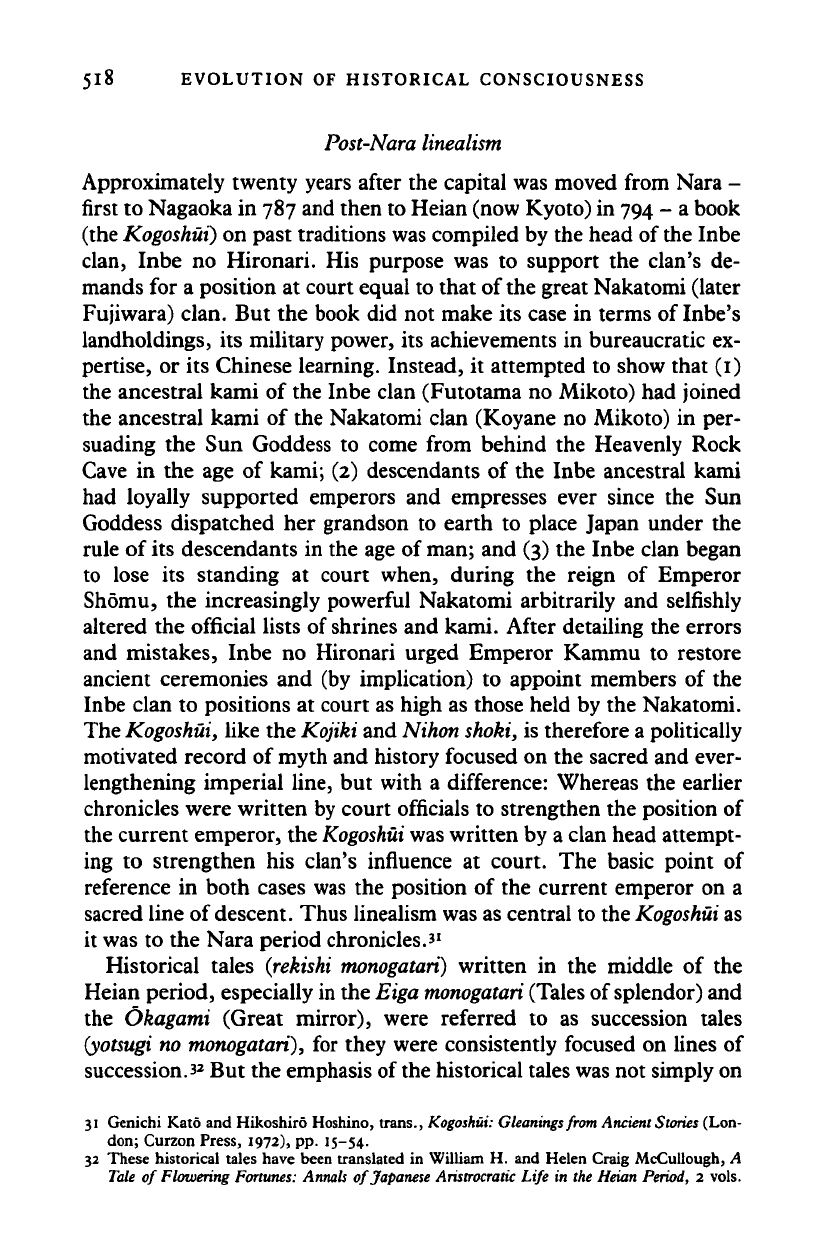
518 EVOLUTION OF HISTORICAL CONSCIOUSNESS
Post-Nara linealism
Approximately twenty years after the capital was moved from Nara -
first to Nagaoka in 787 and then to Heian (now Kyoto) in 794 - a book
(the
Kogoshui)
on past traditions was compiled by the head of the Inbe
clan, Inbe no Hironari. His purpose was to support the clan's de-
mands for a position at court equal to that of the great Nakatomi (later
Fujiwara) clan. But the book did not make its case in terms of Inbe's
landholdings, its military power, its achievements in bureaucratic ex-
pertise, or its Chinese learning. Instead, it attempted to show that (1)
the ancestral kami of the Inbe clan (Futotama no Mikoto) had joined
the ancestral kami of the Nakatomi clan (Koyane no Mikoto) in per-
suading the Sun Goddess to come from behind the Heavenly Rock
Cave in the age of kami; (2) descendants of the Inbe ancestral kami
had loyally supported emperors and empresses ever since the Sun
Goddess dispatched her grandson to earth to place Japan under the
rule of its descendants in the age of man; and (3) the Inbe clan began
to lose its standing at court when, during the reign of Emperor
Shomu, the increasingly powerful Nakatomi arbitrarily and selfishly
altered the official lists of shrines and kami. After detailing the errors
and mistakes, Inbe no Hironari urged Emperor Kammu to restore
ancient ceremonies and (by implication) to appoint members of the
Inbe clan to positions at court as high as those held by the Nakatomi.
The
Kogoshui,
like the
Kojiki
and Nihon
shoki,
is therefore a politically
motivated record of myth and history focused on the sacred and ever-
lengthening imperial line, but with a difference: Whereas the earlier
chronicles were written by court officials to strengthen the position of
the current emperor, the
Kogoshui
was written by a clan head attempt-
ing to strengthen his clan's influence at court. The basic point of
reference in both cases was the position of the current emperor on a
sacred line of
descent.
Thus linealism was as central to the
Kogoshui
as
it was to the Nara period chronicles.3
1
Historical tales
(rekishi monogatari)
written in the middle of the
Heian period, especially in the
Eiga monogatari
(Tales of splendor) and
the Okagami (Great mirror), were referred to as succession tales
(yotsugi
no
monogatari),
for they were consistently focused on lines of
succession.3
2
But the emphasis of the historical tales was not simply on
31 Genichi Kato and Hikoshiro Hoshino, trans., Kogoshui: Gleanings from Ancient Stories (Lon-
don; Curzon Press, 1972), pp. 15-54.
32 These historical tales have been translated in William H. and Helen Craig McCullough, A
Tale of Flowering Fortunes: Annals of Japanese Aristrocratic Life in the Heian
Period,
2 vols.
Cambridge Histories Online © Cambridge University Press, 2008
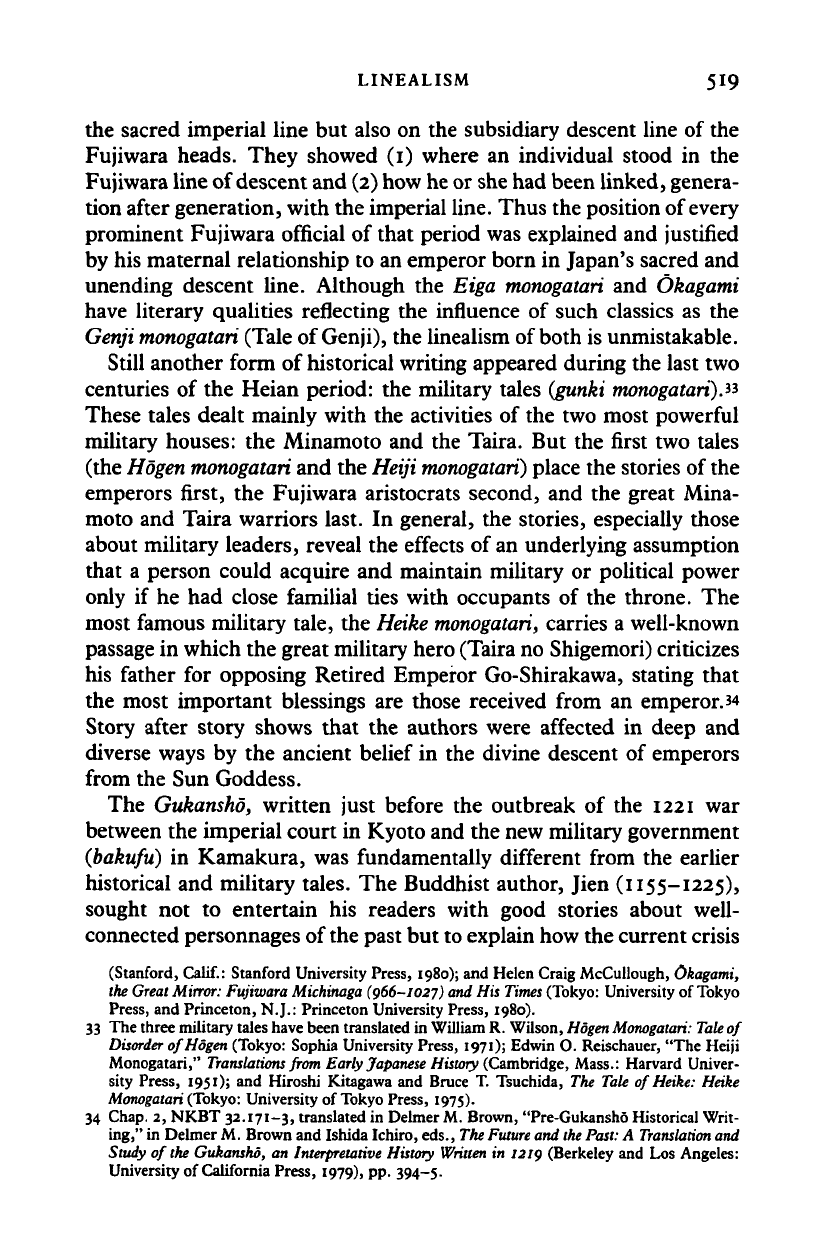
LINEALISM 519
the sacred imperial line but also on the subsidiary descent line of the
Fujiwara heads. They showed (1) where an individual stood in the
Fujiwara line of descent and (2) how he or she had been linked, genera-
tion after generation, with the imperial line. Thus the position of every
prominent Fujiwara official of that period was explained and justified
by his maternal relationship to an emperor born in Japan's sacred and
unending descent line. Although the Eiga
monogatari
and Okagami
have literary qualities reflecting the influence of such classics as the
Genji monogatari
(Tale of Genji), the linealism of both is unmistakable.
Still another form of historical writing appeared during the last two
centuries of the Heian period: the military tales
(gunki
monogatari).**
These tales dealt mainly with the activities of the two most powerful
military houses: the Minamoto and the Taira. But the first two tales
(the
Hogen monogatari
and the
Heiji monogatari)
place the stories of the
emperors first, the Fujiwara aristocrats second, and the great Mina-
moto and Taira warriors last. In general, the stories, especially those
about military leaders, reveal the effects of an underlying assumption
that a person could acquire and maintain military or political power
only if he had close familial ties with occupants of the throne. The
most famous military tale, the
Heike
monogatari,
carries a well-known
passage in which the great military hero (Taira no Shigemori) criticizes
his father for opposing Retired Emperor Go-Shirakawa, stating that
the most important blessings are those received from an emperor. 34
Story after story shows that the authors were affected in deep and
diverse ways by the ancient belief in the divine descent of emperors
from the Sun Goddess.
The Gukansho, written just before the outbreak of the 1221 war
between the imperial court in Kyoto and the new military government
{bakufu)
in Kamakura, was fundamentally different from the earlier
historical and military tales. The Buddhist author, Jien (1155-1225),
sought not to entertain his readers with good stories about well-
connected personnages of the past but to explain how the current crisis
(Stanford,
Calif.:
Stanford University Press, 1980); and Helen Craig McCullough, Okagami,
the Great Mirror: Fujiwara Michinaga (966-1027) and His Times (Tokyo: University of Tokyo
Press,
and Princeton, N.J.: Princeton University Press, 1980).
33 The three military tales have been translated in William R. Wilson, Hogen
Monogatari:
Tale
of
Disorder
of Hogen (Tokyo: Sophia University Press, 1971); Edwin O. Reischauer, "The Heiji
Monogatari,"
Translations
from Early Japanese History (Cambridge, Mass.: Harvard Univer-
sity Press, 1951); and Hiroshi Kitagawa and Bruce T. Tsuchida, The Tale of Heike: Heike
Monogatari (Tokyo: University of Tokyo Press, 1975).
34 Chap. 2, NKBT 32.171-3, translated in Delmer M. Brown, "Pre-Gukansho Historical Writ-
ing," in Delmer M. Brown and Ishida Ichiro, eds., The Future and the Past: A
Translation
and
Study of the Gukansho, an Interpretative History Written in 1219 (Berkeley and Los Angeles:
University of California Press, 1979), pp. 394-5.
Cambridge Histories Online © Cambridge University Press, 2008
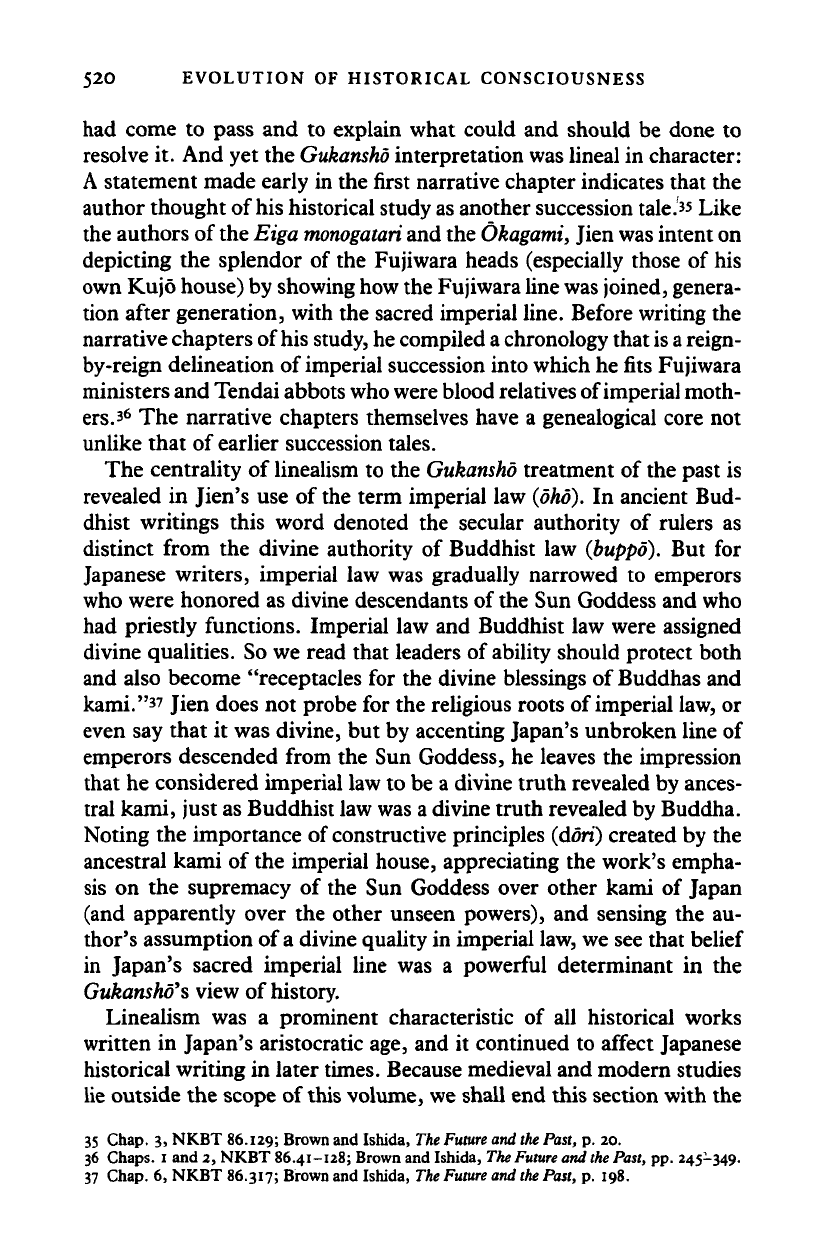
520 EVOLUTION OF HISTORICAL CONSCIOUSNESS
had come to pass and to explain what could and should be done to
resolve it. And yet the
Gukansho
interpretation was lineal in character:
A statement made early in the first narrative chapter indicates that the
author thought of his historical study as another succession
tale.**
Like
the authors of the Eiga
monogatari
and the
Okagami,
Jien was intent on
depicting the splendor of the Fujiwara heads (especially those of his
own Kujo house) by showing how the Fujiwara
line was
joined, genera-
tion after generation, with the sacred imperial line. Before writing the
narrative chapters of his study, he compiled
a
chronology that
is a
reign-
by-reign delineation of imperial succession into which he fits Fujiwara
ministers and Tendai abbots
who
were blood relatives of imperial moth-
ers.
36
The narrative chapters themselves have a genealogical core not
unlike that of earlier succession tales.
The centrality of linealism to the
Gukansho
treatment of the past is
revealed in Jien's use of the term imperial law
(oho).
In ancient Bud-
dhist writings this word denoted the secular authority of rulers as
distinct from the divine authority of Buddhist law
(buppo).
But for
Japanese writers, imperial law was gradually narrowed to emperors
who were honored as divine descendants of the Sun Goddess and who
had priestly functions. Imperial law and Buddhist law were assigned
divine qualities. So we read that leaders of ability should protect both
and also become "receptacles for the divine blessings of Buddhas and
kami."
37
Jien does not probe for the religious roots of imperial law, or
even say that it was divine, but by accenting Japan's unbroken line of
emperors descended from the Sun Goddess, he leaves the impression
that he considered imperial law to be a divine truth revealed by ances-
tral kami, just as Buddhist law was a divine truth revealed by Buddha.
Noting the importance of constructive principles (don) created by the
ancestral kami of the imperial house, appreciating the work's empha-
sis on the supremacy of the Sun Goddess over other kami of Japan
(and apparently over the other unseen powers), and sensing the au-
thor's assumption of
a
divine quality in imperial law, we see that belief
in Japan's sacred imperial line was a powerful determinant in the
Gukansho's
view of history.
Linealism was a prominent characteristic of all historical works
written in Japan's aristocratic age, and it continued to affect Japanese
historical writing in later times. Because medieval and modern studies
lie outside the scope of
this
volume, we shall end this section with the
35 Chap. 3, NKBT 86.129; Brown and Ishida,
The Future
and
the
Past,
p. 20.
36 Chaps. 1 and 2, NKBT 86.41-128; Brown and Ishida,
The Future
and
the
Past,
pp. 245-349.
37 Chap. 6, NKBT 86.317; Brown and Ishida,
The Future
and
the
Past,
p. 198.
Cambridge Histories Online © Cambridge University Press, 2008
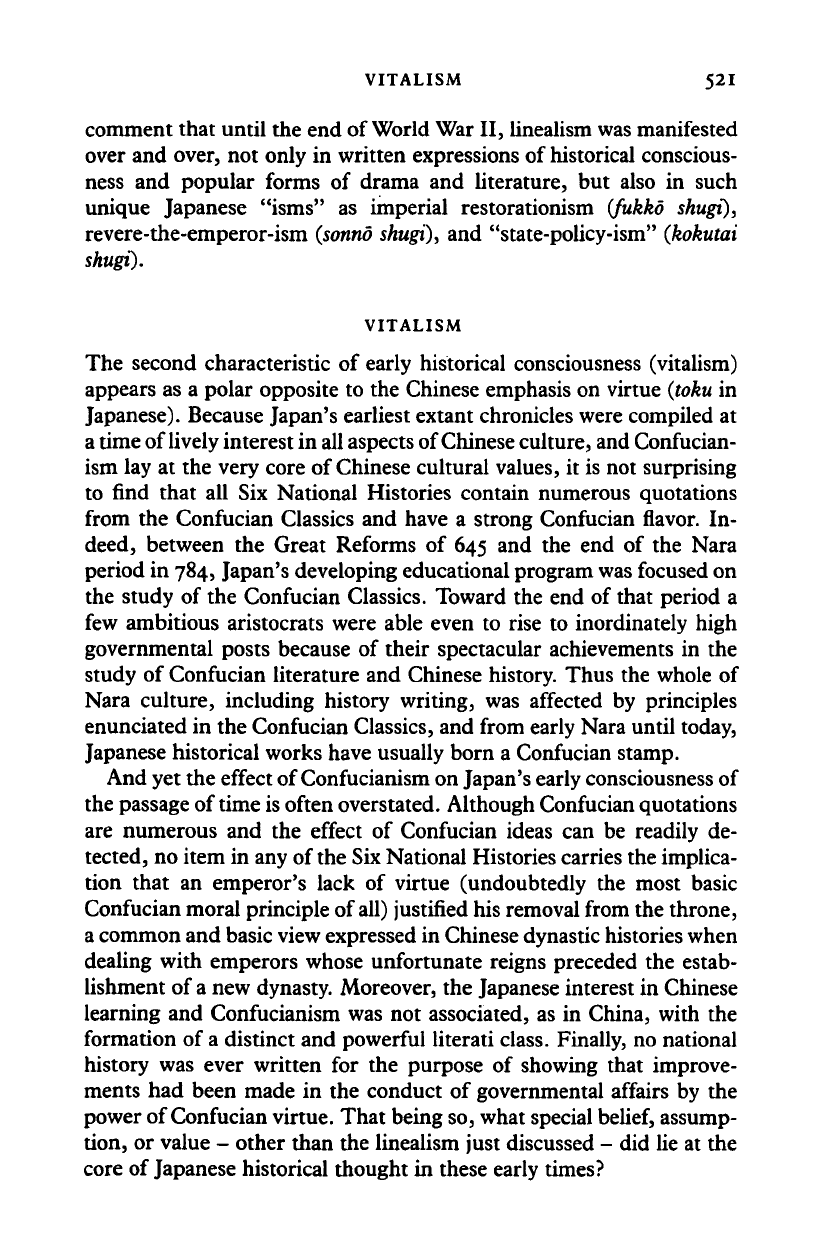
VITALISM 521
comment that until the end of World War II, linealism was manifested
over and over, not only in written expressions of historical conscious-
ness and popular forms of drama and literature, but also in such
unique Japanese "isms" as imperial restorationism (fukko shugi),
revere-the-emperor-ism
(sonno
shugi),
and "state-policy-ism"
(kokutai
shugi).
VITALISM
The second characteristic of early historical consciousness (vitalism)
appears as a polar opposite to the Chinese emphasis on virtue
(toku
in
Japanese). Because Japan's earliest extant chronicles were compiled at
a time of lively interest in all aspects of Chinese culture, and Confucian-
ism lay at the very core of Chinese cultural values, it is not surprising
to find that all Six National Histories contain numerous quotations
from the Confucian Classics and have a strong Confucian flavor. In-
deed, between the Great Reforms of 645 and the end of the Nara
period in 784, Japan's developing educational program was focused on
the study of the Confucian Classics. Toward the end of that period a
few ambitious aristocrats were able even to rise to inordinately high
governmental posts because of their spectacular achievements in the
study of Confucian literature and Chinese history. Thus the whole of
Nara culture, including history writing, was affected by principles
enunciated in the Confucian Classics, and from early Nara until today,
Japanese historical works have usually born a Confucian stamp.
And yet the effect of Confucianism on Japan's early consciousness of
the passage of time is often overstated. Although Confucian quotations
are numerous and the effect of Confucian ideas can be readily de-
tected, no item in any of
the
Six National Histories carries the implica-
tion that an emperor's lack of virtue (undoubtedly the most basic
Confucian moral principle of all) justified his removal from the throne,
a common and basic view expressed in Chinese dynastic histories when
dealing with emperors whose unfortunate reigns preceded the estab-
lishment of
a
new dynasty. Moreover, the Japanese interest in Chinese
learning and Confucianism was not associated, as in China, with the
formation of a distinct and powerful literati class. Finally, no national
history was ever written for the purpose of showing that improve-
ments had been made in the conduct of governmental affairs by the
power of Confucian virtue. That being so, what special
belief,
assump-
tion, or value - other than the linealism just discussed - did lie at the
core of Japanese historical thought in these early times?
Cambridge Histories Online © Cambridge University Press, 2008
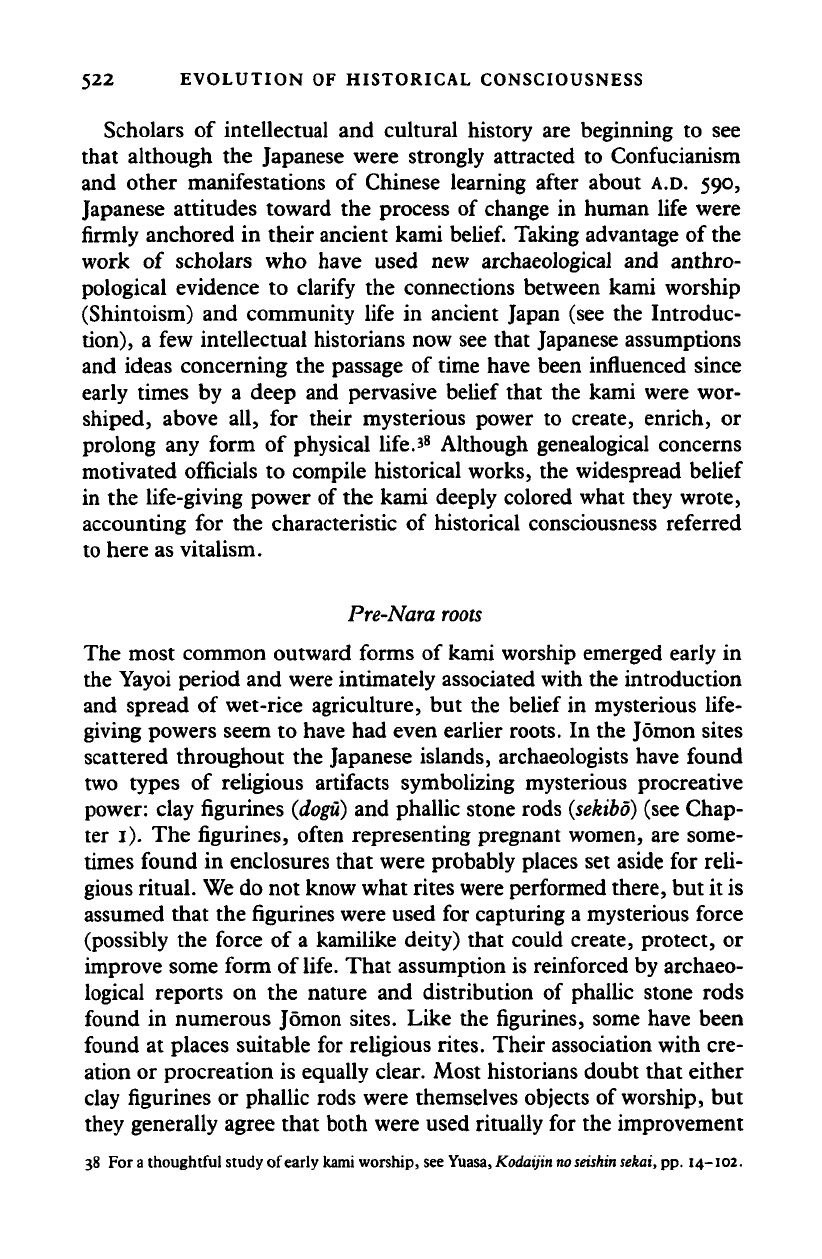
522 EVOLUTION OF HISTORICAL CONSCIOUSNESS
Scholars of intellectual and cultural history are beginning to see
that although the Japanese were strongly attracted to Confucianism
and other manifestations of Chinese learning after about A.D. 590,
Japanese attitudes toward the process of change in human life were
firmly anchored in their ancient kami
belief.
Taking advantage of the
work of scholars who have used new archaeological and anthro-
pological evidence to clarify the connections between kami worship
(Shintoism) and community life in ancient Japan (see the Introduc-
tion),
a few intellectual historians now see that Japanese assumptions
and ideas concerning the passage of time have been influenced since
early times by a deep and pervasive belief that the kami were wor-
shiped, above all, for their mysterious power to create, enrich, or
prolong any form of physical life.*
8
Although genealogical concerns
motivated officials to compile historical works, the widespread belief
in the life-giving power of the kami deeply colored what they wrote,
accounting for the characteristic of historical consciousness referred
to here as vitalism.
Pre-Nara
roots
The most common outward forms of kami worship emerged early in
the Yayoi period and were intimately associated with the introduction
and spread of wet-rice agriculture, but the belief in mysterious life-
giving powers seem to have had even earlier roots. In the Jomon sites
scattered throughout the Japanese islands, archaeologists have found
two types of religious artifacts symbolizing mysterious procreative
power: clay figurines
(dogu)
and phallic stone rods
(sekibo)
(see Chap-
ter 1). The figurines, often representing pregnant women, are some-
times found in enclosures that were probably places set aside for reli-
gious ritual. We do not know what rites were performed there, but it is
assumed that the figurines were used for capturing a mysterious force
(possibly the force of a kamilike deity) that could create, protect, or
improve some form of
life.
That assumption is reinforced by archaeo-
logical reports on the nature and distribution of phallic stone rods
found in numerous Jomon sites. Like the figurines, some have been
found at places suitable for religious rites. Their association with cre-
ation or procreation is equally clear. Most historians doubt that either
clay figurines or phallic rods were themselves objects of worship, but
they generally agree that both were used ritually for the improvement
38 For
a
thoughtful study of early kami worship, see Yuasa, Kodaijin
no seishin
sekai, pp. 14-102.
Cambridge Histories Online © Cambridge University Press, 2008
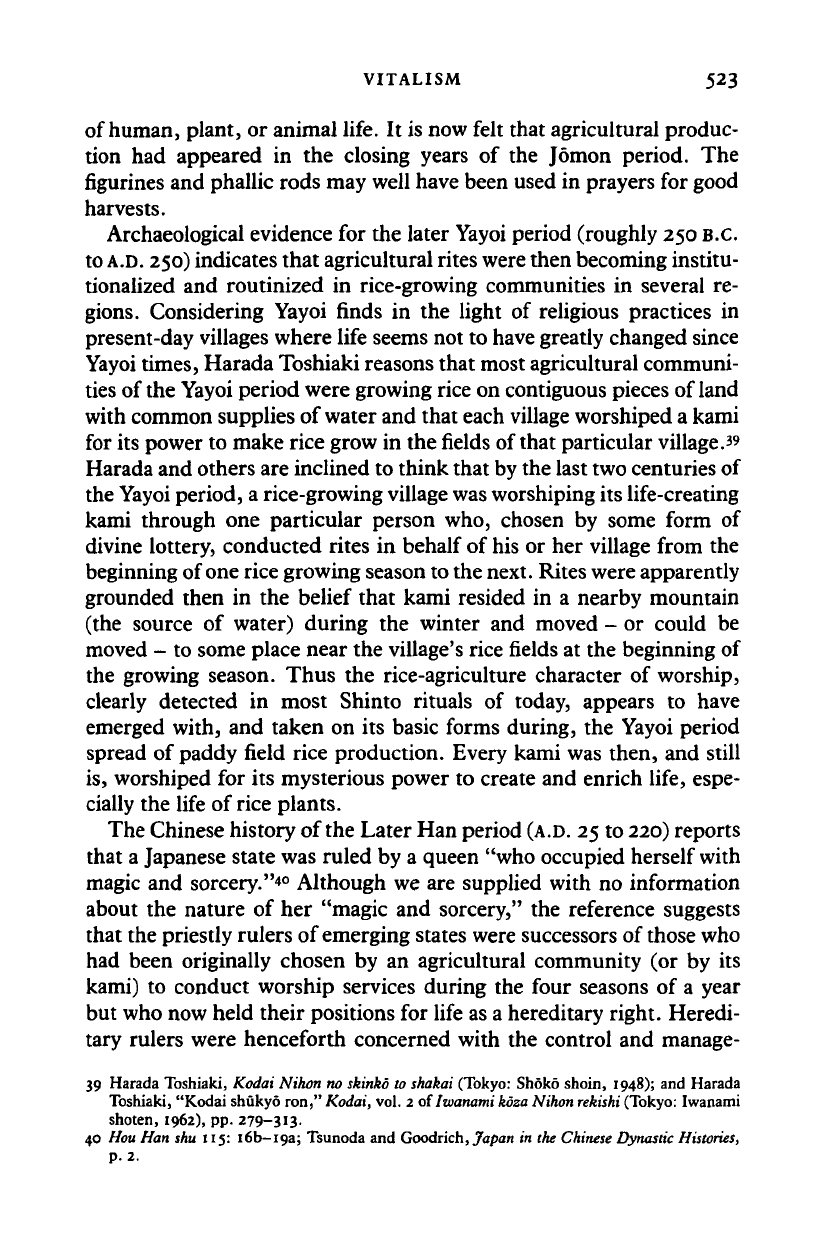
VITALISM 523
of human, plant, or animal life. It is now felt that agricultural produc-
tion had appeared in the closing years of the Jomon period. The
figurines and phallic rods may well have been used in prayers for good
harvests.
Archaeological evidence for the later Yayoi period (roughly 250 B.C.
to
A.D.
250) indicates that agricultural rites were then becoming institu-
tionalized and routinized in rice-growing communities in several re-
gions.
Considering Yayoi finds in the light of religious practices in
present-day villages where life seems not to have greatly changed since
Yayoi times, Harada Toshiaki reasons that most agricultural communi-
ties of
the
Yayoi period were growing rice on contiguous pieces of land
with common supplies of water and that each village worshiped a kami
for its power to make rice grow in the
fields
of that particular village.
39
Harada and others are inclined to think that by the last two centuries of
the Yayoi period, a rice-growing village
was
worshiping its life-creating
kami through one particular person who, chosen by some form of
divine lottery, conducted rites in behalf of his or her village from the
beginning of one rice growing season to the next. Rites were apparently
grounded then in the belief that kami resided in a nearby mountain
(the source of water) during the winter and moved - or could be
moved - to some place near the village's rice
fields
at the beginning of
the growing season. Thus the rice-agriculture character of worship,
clearly detected in most Shinto rituals of today, appears to have
emerged with, and taken on its basic forms during, the Yayoi period
spread of paddy field rice production. Every kami was then, and still
is,
worshiped for its mysterious power to create and enrich life, espe-
cially the life of rice plants.
The Chinese history of the Later Han period
(A.D.
25 to 220) reports
that a Japanese state was ruled by a queen "who occupied herself with
magic and sorcery."
40
Although we are supplied with no information
about the nature of her "magic and sorcery," the reference suggests
that the priestly rulers of emerging states were successors of those who
had been originally chosen by an agricultural community (or by its
kami) to conduct worship services during the four seasons of a year
but who now held their positions for life as a hereditary right. Heredi-
tary rulers were henceforth concerned with the control and manage-
39 Harada Toshiaki, Kodai Nihon no skinko to shakai (Tokyo: Shoko shoin, 1948); and Harada
Toshiaki, "Kodai shukyo ron," Kodai, vol. 2 of Iwanami koza Nihon rekishi (Tokyo: Iwanami
shoten, 1962), pp. 279-313.
40 Hou Han shu 115: i6b-i9a; Tsunoda and Goodrich, Japan in the Chinese Dynastic Histories,
p.
2.
Cambridge Histories Online © Cambridge University Press, 2008
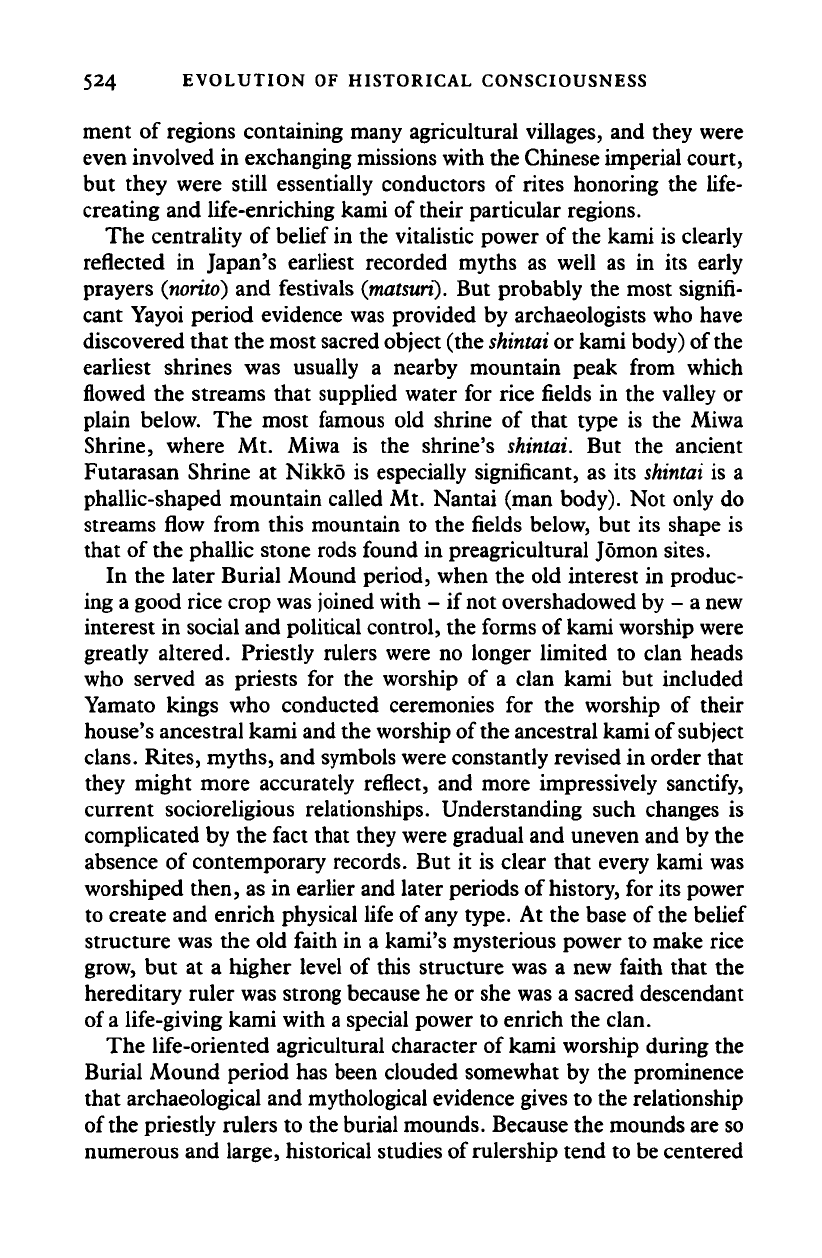
524 EVOLUTION OF HISTORICAL CONSCIOUSNESS
ment of regions containing many agricultural villages, and they were
even involved in exchanging missions with the Chinese imperial court,
but they were still essentially conductors of rites honoring the life-
creating and life-enriching kami of their particular regions.
The centrality of belief in the vitalistic power of the kami is clearly
reflected in Japan's earliest recorded myths as well as in its early
prayers
(norito)
and festivals
(matsuri).
But probably the most signifi-
cant Yayoi period evidence was provided by archaeologists who have
discovered that the most sacred object (the
shintai
or kami body) of the
earliest shrines was usually a nearby mountain peak from which
flowed the streams that supplied water for rice fields in the valley or
plain below. The most famous old shrine of that type is the Miwa
Shrine, where Mt. Miwa is the shrine's shintai. But the ancient
Futarasan Shrine at Nikko is especially significant, as its
shintai
is a
phallic-shaped mountain called Mt. Nantai (man body). Not only do
streams flow from this mountain to the fields below, but its shape is
that of the phallic stone rods found in preagricultural Jomon sites.
In the later Burial Mound period, when the old interest in produc-
ing a good rice crop was joined with - if not overshadowed by - a new
interest in social and political control, the forms of kami worship were
greatly altered. Priestly rulers were no longer limited to clan heads
who served as priests for the worship of a clan kami but included
Yamato kings who conducted ceremonies for the worship of their
house's ancestral kami and the worship of the ancestral kami of subject
clans.
Rites, myths, and symbols were constantly revised in order that
they might more accurately reflect, and more impressively sanctify,
current socioreligious relationships. Understanding such changes is
complicated by the fact that they were gradual and uneven and by the
absence of contemporary records. But it is clear that every kami was
worshiped then, as in earlier and later periods of
history,
for its power
to create and enrich physical life of any type. At the base of the belief
structure was the old faith in a kami's mysterious power to make rice
grow, but at a higher level of this structure was a new faith that the
hereditary ruler was strong because he or she was a sacred descendant
of
a
life-giving kami with a special power to enrich the clan.
The life-oriented agricultural character of kami worship during the
Burial Mound period has been clouded somewhat by the prominence
that archaeological and mythological evidence gives to the relationship
of the priestly rulers to the burial mounds. Because the mounds are so
numerous and large, historical studies of rulership tend to be centered
Cambridge Histories Online © Cambridge University Press, 2008
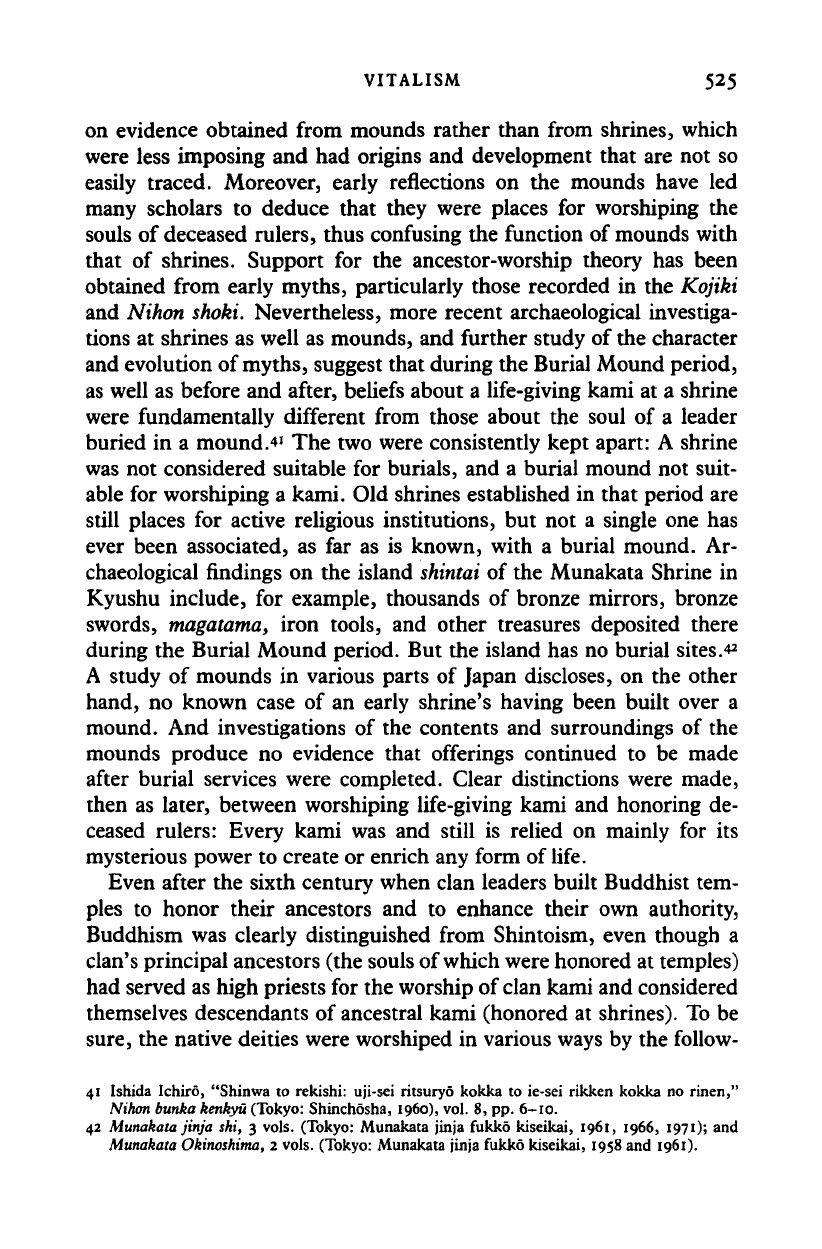
VITALISM 525
on evidence obtained from mounds rather than from shrines, which
were less imposing and had origins and development that are not so
easily traced. Moreover, early reflections on the mounds have led
many scholars to deduce that they were places for worshiping the
souls of deceased rulers, thus confusing the function of mounds with
that of shrines. Support for the ancestor-worship theory has been
obtained from early myths, particularly those recorded in the Kojiki
and Nihon
shoki.
Nevertheless, more recent archaeological investiga-
tions at shrines as well as mounds, and further study of the character
and evolution of myths, suggest that during the Burial Mound period,
as well as before and after, beliefs about a life-giving kami at a shrine
were fundamentally different from those about the soul of a leader
buried in a mound.*' The two were consistently kept apart: A shrine
was not considered suitable for burials, and a burial mound not suit-
able for worshiping a kami. Old shrines established in that period are
still places for active religious institutions, but not a single one has
ever been associated, as far as is known, with a burial mound. Ar-
chaeological findings on the island
shintai
of the Munakata Shrine in
Kyushu include, for example, thousands of bronze mirrors, bronze
swords, magatama, iron tools, and other treasures deposited there
during the Burial Mound period. But the island has no burial sites.*
2
A study of mounds in various parts of Japan discloses, on the other
hand, no known case of an early shrine's having been built over a
mound. And investigations of the contents and surroundings of the
mounds produce no evidence that offerings continued to be made
after burial services were completed. Clear distinctions were made,
then as later, between worshiping life-giving kami and honoring de-
ceased rulers: Every kami was and still is relied on mainly for its
mysterious power to create or enrich any form of life.
Even after the sixth century when clan leaders built Buddhist tem-
ples to honor their ancestors and to enhance their own authority,
Buddhism was clearly distinguished from Shintoism, even though a
clan's principal ancestors (the souls of which were honored at temples)
had served as high priests for the worship of clan kami and considered
themselves descendants of ancestral kami (honored at shrines). To be
sure,
the native deities were worshiped in various ways by the follow-
41 Ishida Ichiro, "Shinwa to rekishi: uji-sei ritsuryo kokka to ie-sei rikken kokka no rinen,"
Nihon bunka kenkyu (Tokyo: Shinchosha, i960), vol. 8, pp. 6-10.
42 Munakata jinja shi, 3 vols. (Tokyo: Munakata jinja fukko kiseikai, 1961, 1966, 1971); and
Munakata Okinoshima, 2 vols. (Tokyo: Munakata jinja fukko kiseikai, 1958 and 1961).
Cambridge Histories Online © Cambridge University Press, 2008
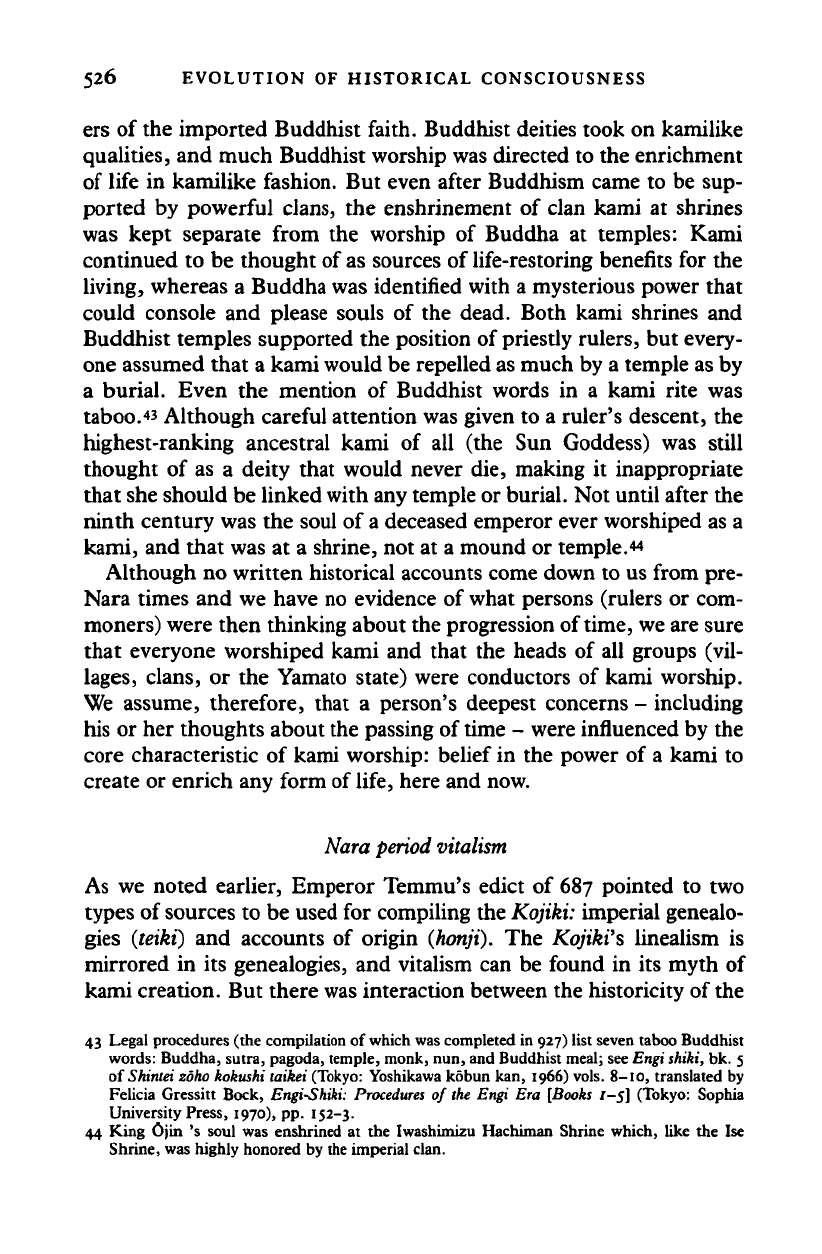
526 EVOLUTION OF HISTORICAL CONSCIOUSNESS
ers of the imported Buddhist faith. Buddhist deities took on kamilike
qualities, and much Buddhist worship was directed to the enrichment
of life in kamilike fashion. But even after Buddhism came to be sup-
ported by powerful clans, the enshrinement of clan kami at shrines
was kept separate from the worship of Buddha at temples: Kami
continued to be thought of as sources of life-restoring benefits for the
living, whereas a Buddha was identified with a mysterious power that
could console and please souls of the dead. Both kami shrines and
Buddhist temples supported the position of priestly rulers, but every-
one assumed that a kami would be repelled as much by a temple as by
a burial. Even the mention of Buddhist words in a kami rite was
taboo.
43
Although careful attention was given to a ruler's descent, the
highest-ranking ancestral kami of all (the Sun Goddess) was still
thought of as a deity that would never die, making it inappropriate
that she should be linked with any temple or burial. Not until after the
ninth century was the soul of
a
deceased emperor ever worshiped as a
kami, and that was at a shrine, not at a mound or temple.
44
Although no written historical accounts come down to us from pre-
Nara times and we have no evidence of what persons (rulers or com-
moners) were then thinking about the progression of
time,
we are sure
that everyone worshiped kami and that the heads of all groups (vil-
lages,
clans, or the Yamato state) were conductors of kami worship.
We assume, therefore, that a person's deepest concerns - including
his or her thoughts about the passing of time - were influenced by the
core characteristic of kami worship: belief in the power of a kami to
create or enrich any form of life, here and now.
Nara period vitalism
As we noted earlier, Emperor Temmu's edict of 687 pointed to two
types of sources to be used for compiling the
Kojiki:
imperial genealo-
gies (teikt) and accounts of origin (honji). The Kojiki's linealism is
mirrored in its genealogies, and vitalism can be found in its myth of
kami creation. But there was interaction between the historicity of the
43 Legal procedures (the compilation of which was completed in 927) list seven taboo Buddhist
words: Buddha, sutra, pagoda, temple, monk, nun, and Buddhist meal; see Engi shiki, bk. 5
of Shiniei zoho kokushi laikei (Tokyo: Yoshikawa kobun kan, 1966) vols. 8-10, translated by
Felicia Gressitt Bock, Engi-Shiki: Procedures of the Engi Era [Books l-s] (Tokyo: Sophia
University Press, 1970), pp. 152-3.
44 King Ojin 's soul was enshrined at the Iwashimizu Hachiman Shrine which, like the Ise
Shrine, was highly honored by the imperial clan.
Cambridge Histories Online © Cambridge University Press, 2008
